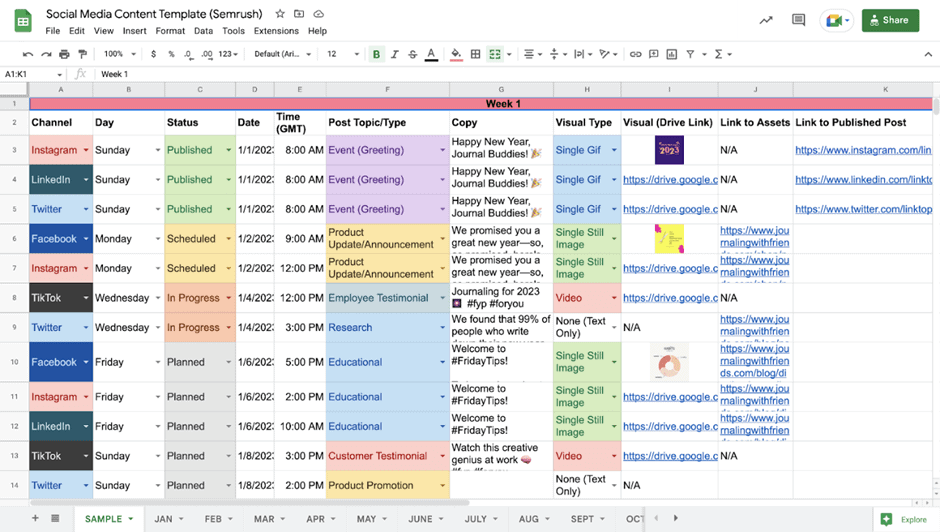Need some tips on how to manage multiple social media accounts at the same time?
You’re not alone. Social media management has become such a core part of many organizations’ marketing strategy that it’s not unusual for one social media manager to have to juggle five, 10, or even 20 channels at once.
If it feels a little overwhelming, don’t worry. We’ve got some top tips that will help you become more efficient as well as make your life a lot easier. Let’s dive in.
How to manage multiple social media accounts efficiently
There are a number of reasons why you might want to run multiple social media accounts. For starters, if you need to reach different target audiences, you’re likely to find them on different social media sites. Usage of social sites varies widely by demographic, and you need to meet your audiences where they are.
In addition, it can make sense to have separate accounts even on the same platform. The kind of situations this can be useful for include:
- A large company that’s present in multiple markets wants separate accounts for each country
- Your general feed is getting swamped by customer service requests, so you decide to create a dedicated support channel
- Your business offers several completely unrelated services
Whatever your reasons for having a number of accounts, it’s crucial to curate them properly. We’re going to cover seven strategies for managing multiple accounts so that you can get the most out of each one.
First, let’s talk about social media tools.

Free to use image sourced from Unsplash
Selecting social media tools
There are a huge number of social media tools available to help you stay consistent with your posting. They cover every aspect of channel management, from creating content to automating your posting schedule.
These tools are a massive time-saver and are absolutely crucial when you have lots of accounts to handle.
Other popular types of social media tools include:
- Image tools
- Social media monitoring tools
- Analytics tools
- Audience engagement tools
But the very first tool anyone managing multiple accounts needs is a dashboard. This lets you work across all of your accounts from a single screen. It greatly simplifies the task of updating multiple accounts regularly because you can see at a glance what has to be done.
When you have all your accounts in one place, it’s easier to maintain a consistent brand voice and imagery across all platforms too. While the messaging you put out on different channels will need to be tailored to each audience, your brand still needs to be identifiable as the same across all of them.
In addition, many dashboard tools double up as great analytics platforms. They’ll provide you with essential details about post engagements, reach, and follower growth. All of this helps you develop a good understanding of how your social media strategy is performing and how you can fine-tune it to make it even better.
Content calendar creation
You need a content calendar! It’s all too easy to lose track of what’s supposed to be posted on each account and when. A content calendar solves this problem.
The very act of creating a content calendar focuses your mind on your social media strategy. There are tools you can use for this, but you can also just use a basic calendar template or even a spreadsheet.
For each post, you need to include:
- Content creation due date
- Planned date and time of publication
- Channel to be published in
- Title of post
- Owner or author
- Status (e.g. assigned, waiting approval, in amends, complete)
- Link to image or video file
- Caption
- Tagged users
- Hashtags
It might seem like overkill to plan, say, every single Instagram post this way—but trust us, you’ll be glad you did.
Visualizing and planning content in a calendar format helps you make sure there’s a good variety of content types. This is important because it’s far too easy to fall back on standard topics or treatments that you know work well to generate engagement.
But if you do that too much, your content will become predictable. Paradoxically, you might even find audience engagement starts to wane a little. So it’s vital to mix it up a bit.
On top of this, using a content calendar makes it much easier to keep track of important dates so they aren’t overlooked. When you’re running a campaign, you’ll want to take advantage of any opportunity to make the most of special occasions – which leads us neatly onto scheduling.

Image sourced from semrush.com
Post scheduling
One of the challenges of running multiple social accounts is making sure you post regularly enough on each of them. After all, if you’re looking to drive brand awareness, you need to make yourself seen often.
A complicating factor here is that the correct posting frequency varies depending on the platform. Post too much, and there’s a risk you’ll reach fewer people. After all, it doesn’t take much for a user to tap on a mute button if they’re getting irritated by what they see as spamming.
For an ephemeral social site such as Twitter, where the posts disappear into the ether fairly rapidly, you can get away with posting several times a day. On the other hand, you probably want to post less often on Facebook or LinkedIn, for instance.
You can use A/B testing to figure out when the best times to post are. Once you have your answers, it’s a good idea to use a scheduling tool to automate your posting. That way, you know the posts are going up exactly when they’re supposed to.
One aspect of post scheduling that can often be overlooked is how it fits into your broader business operations. If your organization has an event coming up—say, a new product launch—it’s vital to align your social messaging with it.
In some cases, this can mean post scheduling can get quite complicated, especially if there are multiple launches or special events happening regularly.
To cover this situation, you can use enterprise resource planning software (ERP) to make sure everyone working for your business is alert to how things are developing in real time.
This kind of tool also integrates apps such as workforce management software and centralized document storage, so collaboration between departments becomes much easier.
Engaging with followers
Uploading posts is one thing, but if that’s all you’re doing, you’re missing out. Audience engagement is key, and that means interacting with comments and questions posted on your channels.
The more channels you run, the more time this will take up, but it’s a core part of channel management because your audience has to feel as if you’re listening to them. Otherwise, what should have been a positive can quickly turn into a negative.
So set a significant chunk of time aside every day to catch up with the responses to your existing posts. Obviously, it’s not always going to be possible to respond to every single comment, particularly if you’re running channels that get a lot of interaction.
But the more you can do, the better. There are ways of simplifying the task, of course. If you have separate customer support channels, for example, it makes sense to hand over basic day-to-day responsibility for those to the customer service team while you focus on the rest.
There are other approaches you can take as well. If you have the capacity, why not consider running the occasional livestream? This doesn’t need to take much time, but it can really supercharge engagement if done right.
For instance, if you run a small coffee shop, you could livestream a barista teaching someone to make latte art. This would strike the perfect balance of fun and showcasing skill. Whatever you do, make sure to keep it fairly short since no one but your most committed brand fan is likely to tune into an hour-long performance.
The key to interaction is to remember the golden rule: people want to connect with people, not faceless companies. So it’s a good idea to try to humanize your brand. Share behind-the-scenes content, feature individual employees, and try to project the human aspect of your business.

Free to use image sourced from Unsplash
Utilizing social media listening
On top of interacting directly with commenters, you should also be monitoring what people are saying online about your company when they’re not speaking to you directly. This is what’s known as social listening, and it’s powerful.
Now, the issue here is that we’re talking about a lot of data. Lots and lots of data, in fact, if you hope to get meaningful insights from the process. So you’ll be pleased to hear that AI for social listening is a thing.
With AI tools, you can crunch all the data fast in real-time. You’ll be able to achieve a detailed understanding of changing trends and attitudes using techniques such as sentiment analysis and predictive analytics.
You can also check out how well your competitors are doing and how your performance compares to theirs. The kind of information this will yield can give you an edge and can even suggest ideas for new products and services that you may not otherwise have thought of.
Monitoring analytics and performance
It’s crucial to keep on top of every account’s performance. That way, you know what’s working and what isn’t. If you’re using a dashboard tool, this should be pretty straightforward. It will provide you with regular updates and analytics for each one of your channels.
Take the time to pore over them in detail. Check how much engagement each channel is getting and look out for posts that generated a lot of engagement vs. those that didn’t.
What were the differences between them? Are there some subjects that always do well when you post about them? Does the time of day you post have a big impact? These sorts of things can help you fine-tune your strategy.
There are also other tools you can use to get even more out of your analytics. Exactly which ones are right for your organization will depend on what field of work you’re in.
For example, an ecommerce store may benefit from using retail ERP software so that it can integrate its sales and inventory data with its CRM platform. These insights can then be fed into their social media strategy, as they use sales data to inform their customer segmentation and audience targeting.

Free to use image sourced from Unsplash
Managing crisis and negative feedback
Disaster! Something’s gone wrong, and now your organization’s reputation is on the line. Maybe one of your products has to be recalled because it has a dangerous fault. Or perhaps one of your tweets went viral for all the wrong reasons.
Don’t panic. There’s an art to crisis management, and having a plan in place beforehand is the number one rule.
The first thing to do is to make sure you fully understand the scope of the problem. Are we talking about hundreds of thousands of angry customers? Or is this just a case of you unwisely posting a poll that’s been hijacked by pranksters?
Remember that social media moves quickly. You need to determine whether what’s happened is a genuine threat to your brand, and if so, assess how to respond. In many cases, a carefully worded apology goes a long way.
If the problem is that you’re having to deal with a lot of negative feedback, that can be more difficult. It is important to engage with everyone who makes a complaint, because solving their problem is critical if you want to maintain your reputation for good customer service.
The takeaway—think ahead to make the most of your social media
When considering how to manage multiple social media accounts, it’s really all about planning. That means using all the tools at your disposal to make it as easy as possible to know what’s going on at all times.
With a little thought and preparation, you’ll find you can optimize every single one of your accounts and take your brand’s customer engagement to the next level.


